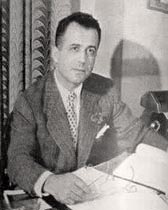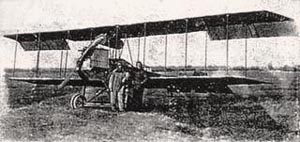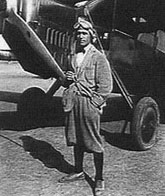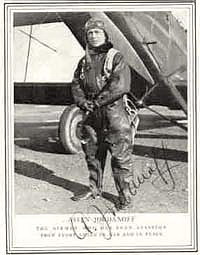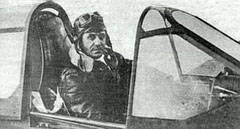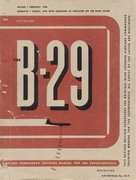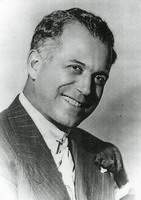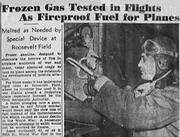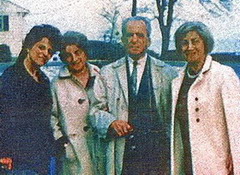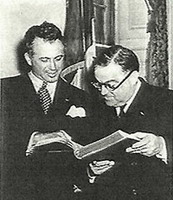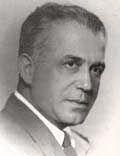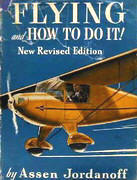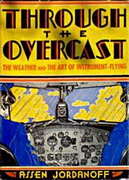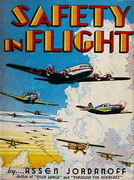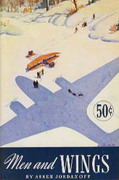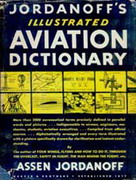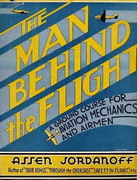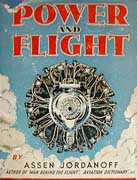Assen Jordanoff - the man who contributed to America's airpowerBrief biography of a great Bulgarian 20th revision, 30 January 2016 |
|
|||
|
By Plamen Antonov |
||||
This study follows the life of Assen Jordanoff from his birth and childhood, through his striking career in Bulgaria and America, to the end of his life, trying to keep close to the facts and avoid exaggerations and typical overworks and myths. It is mostly based on the book by Jordanoff's sister Milka Markowa-Totevy, written in tribute to her brother, on Jordanoff's own books, and on some other sources as well.
Assen Jordanoff's career, after its brilliant beginning in Bulgaria, belongs to the development of aviation in America. Jordanoff occupied a distinct place among distinguished airmen at a given time - the Golden Age of Aviation.
|
Assen Jordanoff. |
"Jordanoff's contribution was essential to the advancement of U.S. aviation, thanks to his instructional/analytical books in the field of aeronautics and its processes, as well as thanks to the direct application of his engineering and practical skills in the building of aircraft. Jordanoff directly participated in the creation of important flying craft during WWII. One of them was P-40, which was present on all the combat sites and played a major part in air-to-air or air-to-ground confrontations. Another plane that greatly owes to him was the P-38, a 2-motor fighter having a large degree of mobility and range. It had a predominant role in the Pacific War, although it could be useful for many other purposes as well. The third plane whose construction was due to Jordanoff was the B-17 bomber, which became an indispensable unit in our strategic bombing forces, and was present on all the battlefields in Europe." General
Ronald R. Fogleman |
Worldwide known aviation pioneer and aircraft designer was born on September 2nd, 1896, on Denkoglu St. in Sofia, Bulgaria. That was the beginning of a remarkable life and later a striking career.
Young Assen rose in Dr. Christo Jordanoff's family. Dr. Jordanoff (1861 - 1928) was a well educated man. He graduated from the University of Stutgart, Germany, where he studied economics and chemistry and later obtained a doctorate from the University in Aachen, Germany, where he specialized in the analysis and production of wool. In Padua, Italy he practiced silk manufacturing. Dr. Jordanoff spoke four languages: German, Russian, French and Italian, enabling him to pursue research. He published articles on a number of subjects. In Bulgaria he was a Chief Inspector of silkworm production in The Ministry of Economics and Agriculture, Director of The School of Commerce in Svistov, Administrator of the Bank of Agriculture in Sofia. In addition he had a copper mine - Gladna, two coal mines - Vutchidren and Rakita and a family farm. The life of Assen's father wasn't unclouded, but despite his many misfortunes, he believed in his luck and embarked on new ventures with great enthusiasm and joy. He was something of a dreamer and always shared this with his son.

|
|
The Jordanoffs. From left: Vera, Viola, Dotchka Tzoneva, Assen, Dr. Christo Jordanoff, Milka, Nadya. |
There was a great understanding between Assen's father and his mother Dolia (Dotchka) Tzoneva - Jordanoff (1876 - 1954). She was a daughter of a rich tobacco producer from Razgrad. As a girl she attended a commercial school, then studied singing and the piano in Turin, Italy. Married barely nineteen, she remained utterly devoted to her children and the household, not keen on public events and worldly gatherings. In despite of that she was a well-read and progressive woman in time when there was no planned schooling for young girls. Dotchka Jordanoff was interested in fine cuisine to such an extent that she published a cookbook. She wrote also poems and a number of plays, not meant to be published. Assen's mother nourished a real admiration for her son, she believed in his happiness. Assen remained very attached to her, wrote affectionate letters to her, and, after a separation of twenty-four years, he asked her in 1946 to come to join him in New York.
Assen had a brother - Alexander, who died at 6, and four sisters - Milka, Vera, Nadya and Viola. One of them, Milka Markowa-Totevy, was a violin teacher and made a successful career in Bulgaria and France. In her memory a foundation was established in Princeton, NJ by her son George Markow-Totevy. It also awards scholarships to young Bulgarian violinists wishing to study in France and in the USA.
Before Assen's birth, his mother had a strange dream in which she saw him flying in the sky; for many years she would wonder what it meant, supposing only that some day her son would become a well-known figure.
From a very early stage Assen developed as a lively and enterprising boy who had no end of ways for amusing himself. He used to play and run all the day on the family farm, near the village of Sgorigrad, among the buildings and workers, keeping himself busy with tools, odds and ends, or whatever he could lay his hands on. Already at the time he was fascinated by the magic of flight. There one of his specialties was to open the wings of the farm birds, because he was curious to find out what made them fly. He was even imitating them by jumping from the nearby tree while flapping his arms. Later Assen was interested in everything mechanical that can demonstrate the hidden laws of nature. When his father was a Director of The School of Commerce in Svistov, he allowed him to attend chemistry and physics classes and gave him access to the school's labs. All these factors greatly speeded up his education. When an older boy, one of his favorites was making kites, called at these days by their Turkish name of Djorkua, and seeing them take off to the air. Probably at that time he made a wish someday to conquer the skies.
In 1911 the family moved to Sofia into a duplex apartment of a house on the corner of Tzar Boris and Karnigradska streets. There one of those large apartments provided Assen with a spacious atelier for his undertakings. One of his first inventions there was how to develop film with his hands buried in a box instead of using a whole dark room. In the same year his father took him on a long trip to Italy, Switzerland and France. For the boy this was a first opportunity to see many of the latest models of biplanes, motorcars and motorcycles and other machines - he would spent hours on the exhibit grounds. In order to learn some French his father settled Assen in a boarding school in Geneva. Later he will say that he got fed up with the Swiss sense of discipline, so that one morning he slipped away unnoticed and managed to make his way alone to Grenoble, France, reaching his aunt. When he met up his father, who had come to fetch him, he easily convinced him to buy a motorcycle, for he knew Father shared his weakness for engines and machines: and so they did bring something of a novelty to Sofia in the early years of the century.
Assen's glider. The Blériot school
Assen's first ever flight was in 1912. The Utro (Dawn) newspaper dated February 16th, 1912, published an article entitled 'First Bulgarian glider', which reads: "In the last few days, on the field between the infantry camp and the pioneer barracks, a very young Bulgarian aviator drills with his glider built by himself. He is a high school schoolboy, Assen Jordanoff, the son of the Administrator of the Bank of Agriculture. He is fifteen, passionately keen on aviation and as a child fashioned toys that could fly. Last year, when visiting France and Italy, he saw the biplane of Maslennikov and Tchermak, and from then on thought seriously to conquer the air himself. His glider is a very simple, light affair, based on the constructions of the Wright brothers and of Farman. It is 7 meters long, 1.20 m wide, with a surface area of 14 m2 and weights 23 kg. Yesterday he flew for over 12 minutes and reached an altitude of 10 - 12 m. This young man's glider deserves praise, especially from aviation specialists."
Assen Jordanoff later related: "In fact, I was soon able to construct a real glider despite my meagre resources, making it out of bamboo poles, strong metal wires, parts of a dismantled piano and the two tires of my own bicycle. The whole thing came to resemble something like a huge kite. I convinced one of the army commanders of the nearest barracks to allow me two privates to give me a hand testing the glider in a flight on the training field. The two men ran alongside me for a while until, gaining some speed, I could gradually rise in the air and reach a height of about twelve meters. As I had steering device too, I could manoeuvre and land safely back to where I had started from. I survived! But my famous "kite" wasn't so lucky and didn't come out of the adventure in one piece." The exact date of the first flight is unclear, but after it, on February 5th, the young flier made a second test flight in the presence of an official commission.
 |
|
In this house on Tzar Boris St. in Sofia Assen Jordanoff built his glider. |
Soon afterwards Assen's father bought a Ford car, creating a great excitement for all the family. In 1912 it was among the first vehicles of this kind to be seen in Sofia. Barely 16, and without having a licence, Assen used to drive the car, and in order to make some pocket money for himself, he decided to be a "taxi." One day he picked up a rich couple from Rousse, who wished to be driven to Bankia near Sofia and then back. It turned out that Dr. Jordanoff had helped the gentleman in a difficult moment. Having no children and impressed by Assen's performance and maturity, the couple invited him to go with them on summer holiday to Paris. Permission was granted shortly afterwards and the boy had a second chance of visiting France after only one year. In the same year 1912 took place at the Paris' Le Bourget airfield the first Salon de l'Aviation of the very latest aeronautic achievements and the latest planes, demonstrated by the top pilots of the day. "...It would be much more interesting this time, because I was older and better motivated to learn new things about aviation: above all, I planned to find a means of admission to the well-known Blériot school. ...But naturally, I didn't muster the courage to go in, and wondered whether a sixteen-year-old, coming from the little-known Bulgaria, would ever be admitted past its gates. After all, who could take my ambition to be a pilot seriously? And no-one here knew I had already built a glider, which actually flew. So day after day, I would stand around on the school airfield, watching planes taking off and landing." Spending his time in Étampes, near Paris, where the famous aviation school of Louis Blériot was, gave the eager youngster the chance to see from close-up such fliers, whose names will never be forgotten, as Pégoud, Védrines, Paulhan, Graham-Wright, the Wright brothers and Curtiss. Then one day Assen felt a tap on his shoulder and heard someone saying in pure Bulgarian: "I know perfectly well why you are so taken by all these planes coming and going. Back home I have heard about your glider and you being crazy about aviation." This was the well-known Bulgarian aviator Lieutenant Simeon Petrov. Luck was on Assen's side and without any further ado he was introduced to Louis Blériot himself. Very soon Bulgarian officer-pilots, who were in Étampes for training, were accompanied by their younger countryman. He wasn't officially enrolled and there was no diploma for him, but attending the famous flying school in the company of great aviators played a huge role for the enthusiasm of a future ambitious pilot. The last evening in Paris all the Bulgarians gathered to celebrate the successful graduation. Their spirits rose higher when Commander Petrov stood up and announced: "Gentlemen, I have news for you: the time has come for you to apply your flying skills and show your courage. Get ready! I have just been informed that Turkey is massing its forces along the southern border of our country."
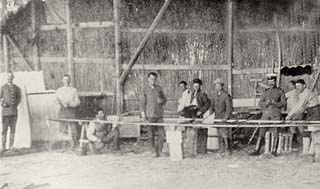 |
|
Assen Jordanoff, seventh from left to right, during repair works on Abatross' wing. Mustapha Pasha airfield. |
In 1912 French press wrote about an incident: during his training Lt. Simeon Petrov flew a Bleriot plane when suddenly its engine stopped. The brave aviator made a successful emergency landing and became thus the first in the world to land a plane with stopped engine. "...This is the only one emergency in aviation, when a sudden engine stop wasn't followed by a disaster." (L'Aero magazine, June 1912) Simeon Petrov's experience was analyzed and later included in the Louis Bleriot's flying school training methods.
War experiences - The Balkan wars
A tough period for Bulgaria had begun - it led three consecutive wars which ended finally with a national catastrophe. The First Balkan War, led by Bulgaria, Serbia and Montenegro, and Greece against Turkey, will be followed by the Second Balkan War, led against Bulgaria by its former allies, and the Great War. Barely 16 Assen Jordanoff volunteered to the army and joined the Aeroplanno Otdelenie (Air Squadron) as a flight observer. He wouldn't be accepted in the army because of his age, but after countless talks and refusals his father finally gave in and put his signature on his son's application. The classes at the Blériot school will soon pay back.
The Aeroplanno Otdelenie was based at one of the first military airfields in the world - Mustapha Pasha, not far from Svilengrad, in 20 km from the front line. Initially it consisted of no more than ten planes, as many technicians besides the pilots, two dogs and Assen Jordanof himself, called by the others Maltchika (The Kid). His first touch to the military aviation wasn't encouraging. When he saw all the airplanes lined up on the field, he was unable to resist and climbed into the first one. Being exhausted he fell asleep in the pilot's seat and was awakened by an animated conversation. Startled he jumped out of the plane and damaged one of the wings. "You damn fool!" - the commander shouted at him... And put him immediately on fatigue duty. A few days later there was a great excitement for all the staff, when two balloons, and more than twenty new aircraft - Blériots, Voisins, Somers and Bristols were delivered from France, Russia, Germany, Romania and Italy. The camp started to look like a proper military set-up.
In 1912 г. Bulgarian army has about 21 airplanes as follows: 3 Albatros, 4 Farman, 1 Voisin, 1 Somer, 1 Sikorsky, 1 Bristol, 2 Nieuport and about 10 Bleriot, thus making its air-force equal to that of countries like Great Britain and leaving behind Italy, The United States and Japan.
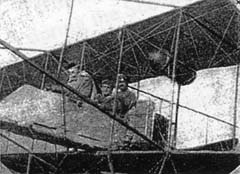 |
|
Assen Jordanoff as an observer in center of Albatross during Balkan Wars. |
The year was still 1912 and no one knew very much or was certain of the airplane's usefulness in warfare, but very soon one of the first military flights, not only for Bulgaria, but for the world, was undertaken. Lieutenant Simeon Petrov, who was the first licensed Bulgarian pilot and first Bulgarian to fly Bulgarian engine propelled plane over Bulgaria on August 13th, 1912, won the chance to show his bravery and the honor to be among first battle pilots in the world by tossing a coin. He and Lt. Christo Topraktchiev as his observer were among the first to use airplane for military purpose under actual conditions of war. Their mission was strictly reconnaissance as machine guns were too heavy for the planes in those days - they will appear on military planes as late as 1915, when Germans fitted a Fokker E1 with one. But already in 1912 the military air bombardment had become a reality. It was performed by Lts. Radoul Milkov and Prodan Taraktchiev, who were among the first military pilots in the world to directly attack the enemy. During a reconnaissance flight they dropped a bomb they have manufactured themselves and another one brought from Russia over the rail station of Dedeagatch near the strong Odrin (Adrianople, Edirne) fortress. Their flight lasted an hour and a half. After it four bullet holes were found in the wings. The brave aviators were congratulated by the Division Commander General Yankov and awarded medals for outstanding bravery. The date was October 16th, 1912. According to military archives first planned aerial bombardment in that war was performed by the Italian volunteer Lt. Giovanni Sabelli and Maj. Vassil Zlatarov on November 17th, 1912.
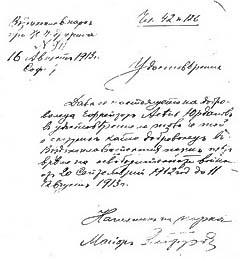
|
|
This document, signed by Maj. Zlatarov, commander of the air squad, certifies that corporal Assen Jordanoff volunteered for the First Balkan War 1912 - 1913. (Click the picture to enlarge) |
World's first military flights took place a few years earlier in The United States. First military plane "Signal Corps 'Aeroplane' No. 1" flew at Fort Sam Houston on March 2nd, 1910 piloted by U.S. Army Lt. Benjamin Foulois. What is known as "birth of military flight" was undertaken under conditions of peace and was just circling the field at the speed of 30 mph for seven and a half minutes. In June 1910 were the first aerial bombardment experiments taken by Glenn Curtiss. The first shot from an airplane was made from a rifle on August 20th, 1910 by Lt. James Fickel with Glenn Curtiss piloting. First takeoff from a warship was made by Eugene Ely on November 14th, 1910 and first carrier landing was on January 18th, 1911.
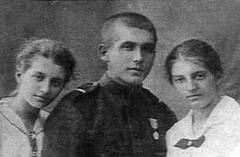
|
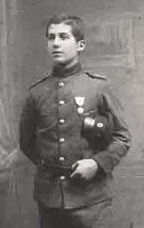
|
|
Corporal Assen Jordanoff. On the first photo with his sisters Vera and Milka. 1913. |
|
Bulgarian triumph was followed soon by a first victim - on October 19th, 1912 the aircraft of Lt. Topraktchiev went down from an altitude of 70 m and burst into flames killing the pilot. So Bulgaria has the sad pride of having the first aviator to die in a war situation. There are two theories regarding the reasons for the crash which led to Topraktchiev's death: that he was wounded to death by enemy fire during his third and last flight over Turkish positions or that the incident was caused by a malfunction in the elevator, which was repaired the day before, and a test flight was performed after that. "...As soon as he climbed to an altitude of 70 m, we saw the craft suddenly head nose-downwards, crash and burst into flames. On all sides we heard what sounded like gunshots: no doubt Topraktchiev had stuffed his pockets with grenades for his scheduled aerial attack. None of us could do anything at all to help the dying pilot trapped in his burning plane. He was the first Bulgarian aviator - and no doubt the first in the world - to die in a war situation".
During those historical events the very young Jordanoff wasn't inactive. As flight observer he flew with the pilots on reconnaissance missions and practiced flying. "During all of this Balkan War, I -- The Kid -- as a volunteer tried to prove my worth by going on the flights and helping the pilots to the best of my ability, while simultaneously trying to learn for myself as much as I could about the mechanics of the planes and about the skills of flying... Eventually I managed to persuade headquarters to let me take practice flying lessons, and the teacher appointed was the Swiss pilot Burrie. I was very keen to master the art of piloting in as short time as possible, so as to be ready to participate in the real flying." Colonel Radul Milkov would later recall: "...Assentcho (Assen) was very interested in airplanes. He was well versed in the subject - he had built a glider. I would often see Assentcho, drawing paper in hand, measuring, taking notes and copying the design of the parts from dismantled machines. He was getting into different planes and flying with almost every pilot as his observer, dropping bombs over Odrin (Edirne)."
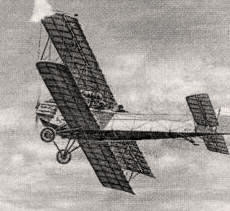 |
|
'Jordanoff-1', the first airplane build in
Bulgaria, during test flig/ht at Bozhuriste airfield. |
In the Aeroplanno Otdelenie Assen gained expertise and was ready to embark by himself on the construction of an airplane - the first Bulgarian airplane, which was finished in less than a year in the summer of 1915. "1915 was a very trying and significant year for me," he said. "There were two sides to it: on the one, I was struggling along with my high school studies, while on the other, I was going to be rewarded with the best success I could ever hope for." At school he got poorest possible grades in three subjects: choir-singing, French (despite his good oral) and drawing - "I didn't care about drawing flowers and vases." He was perfectly happy toiling away on his own with his ideas of constructing a real airplane.
|
|
|
Capt. Radoul Milkov and Assen Jordanoff at the time of the third test
flight of the new plane. |
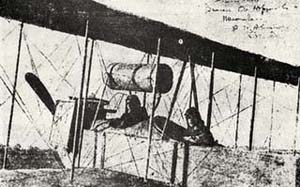
|
|
At the end of the successful test capt.
Radoul Milkov took Assen Jordanoff for a flight with the plane he
developed. |
"My plane was of the Albatross type, 14 m wide, 8.5 m long and burned up 30 liters of oil and 120 liters of gas per hour. It had a feature of its own - my very first real invention - which enabled the craft to regain stability when running into air pockets." Tests didn't run smoothly. First test flight was performed by Gavril Stoyanov on August 8th, 1915 at Bozhuriste airfield near Sofia. He wasn't fascinated by the plane's behavior during the flight which barely ended with a crash. The second pilot who took the risk for testing the new machine was Radul Milkov. On August 10th, 1915 he rose the craft in the air. Initially the flight went normally, but yet at the first turn the plane irresistibly headed nose-down. Only the pilot's skills and nerve prevented tragedy and he stabilized the plane at the lowest possible altitude and landed safely. The machine was checked again and some couplings were retightened. The third test flight was already normal. Assen's emotion was extraordinary seeing his own creation airborne. Soon after he was taken into the air in the rear seat by Radul Milkov. The airplane was called 'Jordanoff-1'.
A special commission set by the Ministry of War and including the most competent airmen at that time made its conclusion: "The plane is safe. There are no mistakes in calculations. The invention is to be recognized and Assen Jordanoof to be recorded as its inventor. August 10th, 1915 is to be considered as starting date of Bulgarian aircraft building."
An article in Sofia daily from October 21st, 1915, reads: "For several days now, in the Indoor Riding Academy of Tzar Ferdinand, the public has been able to view a full-size model of an aircraft put together by the high-school pupil Assen Jordanoff, the son of Dr. Christo Jordanoff, former Administrator of the Bank of Agriculture. This first Bulgarian aeroplane is a successful combination of several existing biplane types. The constructor, who is still in his teens (and already an excellent mathematician), has also introduced a valuable new device, namely a feature which prevents the plane from loosing altitude. Should this innovation prove its value in actual flying conditions, then we will be able to say that the fledging aircraft industry has benefited from a Bulgarian's innovation - something to tickle our sense of national pride."
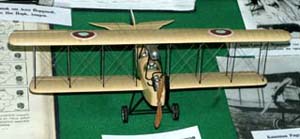
|
|
Model of 'Jordanoff - 1'.
(Click the picture to enlarge)
|
Assen Jordanoff's airplane was at a first look similar to the planes of that time. It was a biplane having a wing section similar to that of Albatross with relatively short wings and increased spacing between them. The fuselage was conceived with great care to diminish drag - a good step ahead in comparison with other constructions. The motor was an Argus brand of 100hp, with front pulling propeller. The landing gear was re-enforced with double tires for stability and safety when landing. The innovation that helped to gain stability was something like additional surfaces, added between the wings and controlled by automatic device. Wings had a wingspan of 14 m and 13 m and a 41 m2 area, plane's length was 8.5 m. The plane, for its time, showed good characteristics: take-off distance - 65 m, landing distance - 50 m, airspeed - 85 km/h, altitude of 500 m reached in 8 minutes.
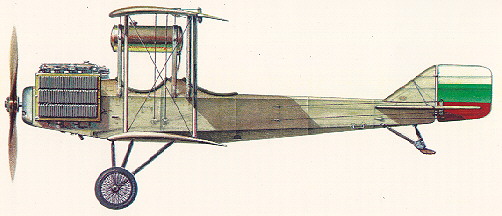
|

|
|
|
Drawings of 'Jordanoff-1'. (Click pictures to enlarge) |
||
After being on exhibit for several months, the plane was bought by the Ministry of Defense for 16,000 leva and his constructor was awarded a scholarship to study engineering abroad. Jordanoff saw his plane as a light liaison, training and cargo plane so this rose his hopes for starting a serial production. His next and even more ambitious project was a heavier multi-engine plane. Unfortunately the World War I cancelled his plans.
War again - military pilot during the First World War
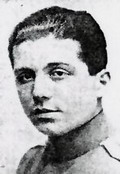 |
||
|
L-t Jordanoff. 1917-1918. |
||
After the successful finishing of his high-school education in Sofia and being already drafted, Assen Jordanoff was incorporated in the reserve officers' training program, wherefrom he entered the flying school of Bozhuriste, near Sofia. The man who insisted on that was one of the first Bulgarian (and one of the first world's combat pilots) Capt. Radoul Milkov.
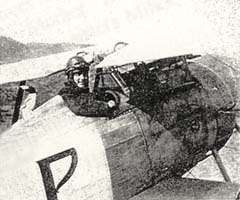 |
|
In a captured Nieuport pursuit plane, model 24, WWI. |
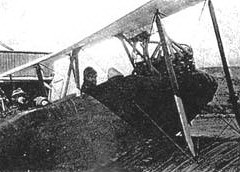 |
|
Taking off on a bombing mission in WWI. |
On graduation the young flier was promoted to podporutchik (second lieutenant) and was assigned to report to the Air Force base of Udovo, on the Western front in Macedonia. With the Vozdushno Otdelenie (Air Squadron) he made 84 sorties and was decorated with an officer's cross 'Za Hrabrost' (Courage Medal) for his exceptional courage. Constantine Popatanassov expressed his admiration for Assen Jordanoff: "Assen Jordanoff was a brave pilot who knew his job very well. We were free of any anxiety taking-off with him on combat missions as we knew that the plane is in good hands and Assen will always be able to handle even the toughest situation. Second lieutenant Assen Jordanoff, military pilot, for his excellent combat performance was decorated with officer's cross 'Za Hrabrost' IV grade, II class."
In his book Your Wings Assen Jordanoff would later recall: "The hostile British fleet had crossed our lines. In a few minutes I was in the air with my pursuit plane ready to meet the enemy. At an altitude of about 10,000 ft. I could see them coming in and encountered ten observation and bombing planes coming right at me. Strangely enough, they did not turn back, even after they saw me. Now, I thought, I may just as well be the aggressive one and start to bring them down one by one, beginning with their leader... I opened fire with my two machine guns right into the leading plane, hoping that he would come down, but for some reason or other he just stayed there. By this time we were so close that I could see the gunner of that plane pouring lead out of his machine gun right at me. To my surprise nothing really happened that I could see, except that my left machine gun ran out of bullets and the right one jammed. At that very instant I felt whizzing bullets pass my ears, singing above the roar of my engine. I took one quick look and noticed three of their pursuit planes throwing their 'ropes', as we called the tracer bullets, around my neck... I pointed the nose of my plane straight earthward and either I was going too fast for them to catch up with me or else they were poor shots..."
Colonel Christo Tchenkov recalls one special occasion when they were greatly enjoyed themselves making fun of the chaplain (called 'pope' in Bulgarian), who was going around all the time complaining that his salary was no more than half of a pilot's. "You know, Father," Assen said, "flying and so gambling with one's life is no easy matter. You have never flown, have you? Why don't you give it a try, see what it's like?" So he took the 'pope' for a spin it the air while comrades watched eagerly and laughingly from beneath at the plane's hopping around, looping the loop once or twice. When they came down, the chaplain, white in his face and trembling with fear, was crossing himself. "God bless you boys!" he exclaimed. "Your pay is well deserved, it really is. Have it all!"
Unfortunately the First World War ended with a national catastrophe for Bulgaria, which during the conflict had sided with Germany and Austria. The malicious Neuilly treaty of 1919 imposed heavy war reprisals, not to speak of the inevitable consequences of war - inflation, penury and joblessness. The Air Force was curtailed to almost nothing - most planes destroyed and fliers dismissed. Assen's wings were cut, but he saw his new chance across the Atlantic.

|
|
This document, issued by the H.M. Air Corps headquarters, certifies that (Click to enlarge) |
In May 1921 Assen and his pilot-comrade Alexander (Sasho) Stoyanov read in a German sports magazine Flugsport an announcement: "The Fédération Aéronautique Internationale, in cooperation with the Aero Clubs of America, Germany and France, has organized a world-circling flight... The contest is to start from New York. Control points have been established at Seattle, Yokohama, Saloniki and Paris... A Grand Prize of One Million Dollars is to be awarded to the flier who first finishes the round trip within 100 days..."
|
|
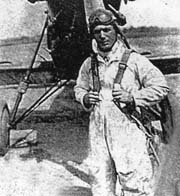 |
|
|
Assen Jordanoff during the 30s. |
||
Jordanoff wrote a letter to the Bulgarian Prime Minister at that time Alexander Stamboliysky: "Given the essence and magnitude of this epoch-making project - the first in the history of aviation and most likely the only one of its kind which will occur in the next decade - it will offer a chance to the envoys of all civilized nations to meet in the air for a chivalrous tournament to be able to measure their respective strength and endurance... We wish to persuade the ministers that we do not seek any particular personal advantages, but only to be given a chance to demonstrate the Bulgarian spirit at its best... our boldness in asking for such support stems from the conviction that we shall, unquestionably, gain victory for Bulgaria, or else we shall meet our fate - courageously - by dying in the line of duty..." Indeed, the government granted Assen Jordanoff and his partner 6,000 dollars to take a part in the great undertaking. By the way, Prime Minister Stamboliysky, who had to sign the Treaty of Neuilly, was one of those who were concerned about Bulgarian aviation and made his best to save at least a part of the airplanes which were meant to be destroyed.
So, the two aviators arrived in America to defend the honour of Bulgaria, but unfortunately the competition was postponed. The New York Times wrote on September 4th, 1921: "Traveled 6000 miles, spent $2,500 doing it and found that the $1,000,000 aviation prize they journeyed to compete for, would not be hung up for a year, may be two years. That was the experience of two young Bulgarian aviators, who told their story yesterday at the Hotel Earle, Waverley Place, near Washington Square." Things became even worse when they read announcements shortly afterwards that "according to the Aero Club of America and the Fédération Aéronautique Internationale the world competition was purely and simply cancelled for good." This brought a total change of their plans, and after thinking it over Jordanoff decided to remain in The United States, later to become his new home.
|
|
|
Being air instructor and also piloting air taxis and doing stunt flights. |
Despite the meager opportunities he could count upon, and despite being unfamiliar with local habits and ways, Assen Jordanoff was impatient to learn as quickly as possible all he could about the latest in the aviation field. His greatest handicap was his non-existing English, so he was unable to display all the abilities in the domains he knew all about. Initially, for lack of anything better, Assen and Sasho ended up shoveling the snow off the city streets. "Thank God, the winter of 1922 was a severe one: snow fell time and again, and there were tons of it all over. Our pay was 50 cents an hour, good enough to buy at the end of the day whatever we needed for our survival." After the snow melted Jordanoff was able to find a construction work on a skyscraper that was being built. Thus having again a job he spent all his free time, evenings and Sundays, at the Public Library, studying English by himself or reading books and manuals on subjects close to his heart: aeronautics, machinery, mechanics.
|
|
|
The pilot and flight instructor Assen Jordanoff. |
After that came his draftsman position at Curtiss-Wright Corporation. Despite the salary that was sufficient for his needs, allowing him to continue with his education, Jordanoff made his best to increase his income, speculating on the many possible opportunities. This gave him good lessons to remember how to survive in the world of business. The years that followed were years of gradual integration in a foreign environment, but also sometimes of deprivations and disappointments. Having mastered the English language to an adequate degree, Assen Jordanoff went on to take university courses in engineering, aeronautics, radio electronics, physics and chemistry. At the same time he graduated from a flying school, his instructor being William Winston, who had also been Lindbergh's instructor. Jordanoff moved soon from the drafting department of Curtiss-Wright to the engineering-planning one and therefrom he would emerge as a test pilot and in parallel, he would be an occasional sales manager, a pilot of air taxis, a stunt pilot and above all a flying instructor. He specialized as well in flying under complex weather conditions, made night and high-altitude flights. Still a young man in his late 20-ties, he already had ten years of flying behind him, his war experience and his applied aeronautical knowledge as constructor. All this would give him the best chances to advance in the growing competitive field of aviation. At that time he became known among his friends and colleagues as Jerry, rather than Assen, a familiar name that would stick to him for the rest of his life.
An interesting happening among Jordanoff's diversified commitments was his conference with Thomas Edison (1847 - 1931). The latter invited Jordanoff to visit him at Menlo Park, NJ as he was at the stage of developing a proto-radar and was also interested in helicopters, a research project in which Assen Jordanoff was involved at the same time. The New York Times from October 2nd, 1930, wrote: "Mr. Edison showed keen interest in the design of the Curtiss Bleacker Helicopter, which is undergoing final ground test here (Curtiss-Wright airport). He compared the design given by Jordanoff with the details of a helicopter machine which he patented in 1910, saying that the helicopter, with its ability to land and take off from small enclosures will answer the airport problem. When told that airports and their sizes were not as serious problem as blind flying through fog, the scientist inquired as to the use of instruments. "That landing problem is terrible. Can't determine your height? Why not drop depth bombs as at sea?" Jordanoff added that present methods were not practical aloft, and voiced the opinion that a fog-penetrating 'artificial eye' was the only solution. To which Mr. Edison replied: "Thus far we converted light into sound. There is no reason for not being able to solve the artificial eye."
Jordanoff's companies - a successful business
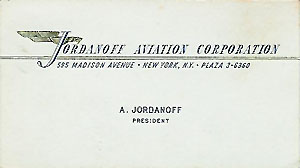  |
|
Jordanoff's business card and company form, 1943. |
After 1940 began a major period in Assen Jordanoff's career. During the next ten years he will establish and preside over his own business enterprises: The Jordanoff Aviation Corporation, to become soon The Jordanoff Corporation, then The Jordanoff Company, before the creation in 1946 of Jordanoff Electronics. Their offices and workrooms were located in the well-known Fuller Building, on the corner of Madison Avenue and E.57th Street in New York, accommodating more than 400 employees. Jordanoff's wide range of technical and scientific knowledge was more than effective and soon he reached and got ahead of his juvenile dreams registering a significant success. As companies' names themselves indicate, their range of activities was progressively enlarging beyond the field of aviation.
As far as aeronautics were concerned, the Jordanoff companies collaborated with such companies as Douglas, Chance-Vought, Lockheed, Curtiss-Wright, McDonnell, Boeing, North American, Consolidated, Piper. At the request of most of them, Jordanoff himself, as a designer or as a planner within his own engineering staff, contributed to a large degree to the construction of some very well-known planes.
 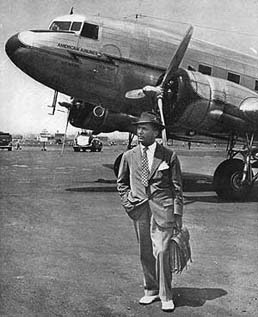 |
|
Jordanoff made a significant contribution to the success of DC-3. |
Among them are: the Lockheed P-38 Lightning - a very versatile aircraft used during WWII mainly as high-speed, high-altitude fighter, long-range escort fighter and photo reconnaissance plane: about 10,000 were built; the Curtiss P-40 Warhawk - America's foremost fighter in service when WWII began. P-40s first engaged Japanese aircraft during the attack on Pearl Harbor; the Boeing B-17 Flying Fortress and the B-29 Super Fortress - the best long-range bombers in WWII that made a significant contribution to defeating Germany and Japan, more than 12,000 B-17s and about 4000 B-29s were built; the Consolidated B-24 Liberator (total of 19,256 were built) and the North American B-25 Mitchell (about 10,000 built): bombers which also had a significant role in WWII; the Douglas DC-3/C-47 Dakota - one of the first airliners and multi-purpose planes, main military air-transport for the Allied Forces during WWII, more than 13,000 were built.
Unfortunately working on two of those planes, the B-17 and the B-24, their constructor didn't know that they will soon bring death and destruction over his own birth place - Sofia. During WWII it was bombed several times by the United States Air Force. The B-29 will also mark the first use of a nuclear weapon over the Japanese cities of Hiroshima and Nagasaki.
An important external circumstance that contributed to the successful growth of the Jordanoff firms is the war effort and especially the Victory program launched in 1942 in The United States - from that year on until 1944 121,257 airplanes were built. Jordanoff participated to his own degree in the national build-up, coming to be closely associated with the Armed Forces industries, in the promotion of ground, sea or air material, for both attack and defense. Also, a very important activity was the preparation and the distribution of thousands of copies of descriptive books and practical manuals, which gave invaluable help to servicemen handling highly complicated equipment. Most of the company projects were top secret.
There is a wide spread belief among military experts that Jordanoff has a direct contribution to shortening the WWII. As his nephew Peter Athanassov says "...he shortened the WWII by delivery in a simple form the knowledge of flying for the huge fleet of the Allied Air Force. The industry delivered the machines, he delivered the people to run them." At that time a humorous anecdote went around: "The war was won 3 months earlier thanks to Jordanoff."
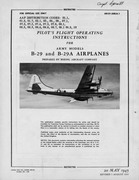
|
||
|
B-29 manuals. |
||
During the years of WWII Jordanoff's reputation was at its height as this letter by the vice-president of Boeing witnesses: "Dear Mr. Jordanoff, The type of presentation of handbooks and manuals you have published covering the operation and maintenance, inspection and repair to aircraft have proven to be highly successful. For this reason, we chose your company to participate with us in the development of the manuals for the Boeing Superfortress, the B-29. These Superfortress manuals are now off the press and you are to be highly commended for the part you played in preparing them. It has been a pleasure to work with your company and we send you every wish for your continual success." Until the end of his life Jordanoff will remain connected to and respected by the Boeing company.
|
|
|
Assen "Jerry" Jordanoff. |
Becoming the largest American manufacturer of specialized military literature had been preceded by Assen Jordanoff's long writing experience. Before emerging as an author of books on flying he was already known as a commentator on aviation events and matters - his articles appeared in dailies and periodicals such as The New York Times, Air News Air Tech, Sportsman Pilot, Popular Science Monthly. He was considered as a prominent authority on all the areas of aviation. His first book was published in 1932 - Flying and How to Do It and was followed by eight other. His books were mostly technical, covering different aspects of aviation, from meteorology to mechanics. The only exclusion is Men and Wings - a history of aviation, subtitled 'Man's Conquest of the Skies'. Some of Jordanoff's books were rapidly reprinted, considered to reach 750,000 to 1,000,000 copies in America and were widely distributed in Great Britain and the USSR (200,000 copies of Your Wings, called there 'Ваши Крылья'). There were also translations in French, Spanish, Italian and even Chinese, but unfortunately not in Bulgarian.
Jordanoff created his own visual education style, his text were rich in illustrations and easy to understand. Immutable was the author's sense of humor. On the last page of Your Wings we read: "If you don't fly now, it isn't my fault." Some books became official hand- or textbooks in some states due to their big practical and scientific value. Thousands of American pilots from several generations owe their knowledge to those books and to their author. Here is what the U.S. plenipotentiary minister in Sofia (1940) George Howard Earl III said when interviewed by the widely read local daily Zora (Dawn): "Almost every one of the 100,000 or so flyers in America, I'm sure, owns his books, and they all read them as if they were a bible to them - a set of precepts... I want to stress here that my son, George, and myself, owe at least ninety per cent of our knowledge on flying to the books of Jordanoff. He is the most famous Bulgarian in America."
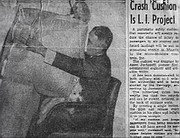
|
||
|
Assen Jordanoff's inventions were widely covered in the press. |
||
Jordanof was also an author of a training film for the United States Air Force called 'Elmer Takes The Air.' It was a re-working of a version originally made for Paramount Pictures in Hollywood. The main role of Elmer was performed by Harold S. Kruger, a highly considered Hollywood stunt actor and a frequent companion of Johnny Weissmuller - Tarzan. The film contained 40 flying lessons, introduced by Jordanoff himself in the role of an instructor. Being part of the method for more effectively and rapidly teaching the pilots, many humorous contradictions and incidents took place in the film, resembling the funny stories and comics in Jordanoff's books. During the war this film was shown in all the American Air Force training bases.
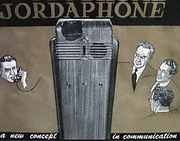
|
|
A magazine ad for the Jordaphone. (Click to enlarge) |
Assen Jordanoff's inventions and innovations seemed to be unlimited. His first notable implemented device was the extra flap-like wing on his 1915-built plane. Another invention was the Frozen Gasoline System for airplanes, which idea was to super-cool the fuel in aircraft's tanks with dry ice and alcohol, thus making it uninflammable - a big advantage to military planes. This system was never finally implemented, but its principles were later adopted in different forms. The Reverse Thrust device was intended to decrease the specific fuel consumption and to increase the trust of jet engines. Assen Jordanoff gave all his attention to the invention and marketing of the Jordaphone, launching for this purpose in 1946 Jordanoff Electronics and investing a considerable capital in the venture. It was officially patented as a 'Cabinet for sound receiving and transmitting apparatus', to which was added 'Telephone system for automatically answering, recording messages and recording normal conversations.' All this came 5 years before the tape recorder and 30 years before the answering machine were put in use. Today's telephones owe a considerable debt to the Jordaphone. Another significant invention were the Airbags (1957) meant to ensure the safety of pilots and automobile drivers. They were in form of protective jackets, and after research has been continued, they are quite common in cars nowadays.
The Stratoport resumed Jordanoff's interest in aviation. A special company was established - The Stratoport Corporation of America (1956). It owned a patent issued for a field of two unidirectional non-crossing runways, set end-to-end pyramid-like elevated structure, to slow planes that are landing and to speed those taking off. The runways were screened by high perforated fences intended to reduce crosswinds. The high screens were also expected to reduce the noise as well as the elevated ends were meant to reduce the length of the runways. Such an approach is recently used for some aircraft carriers. Nonetheless, as was the case with the Jordaphone, the new concept was too ambitious and modernistic - it would have required a total reviewing of airfield procedures, for which an agreement with many companies was also necessary, so in the 50s no acceptance and realization of the plan could be hoped for.
|
|
|
Assen Jordanoff in 1957 and his sisters Milka and Viola and his nephew George: they also live in the United States. |
|
|
|
Assen Jordanoff in 1967 together with his sisters Viola, Milka and Nadya. |
When in 1962 Jordanoff retired, he settled with his third wife Lucille in a cottage on 7 Emerson Place in Harrison, NY. Strangely enough, this choice of a new residence unexpectedly brought back to him memories of some earlier flying contacts, for this was the town where had lived Amelia Earhart whom he knew personally. She was the first world aviatrix, doomed to disappear mysteriously over the Pacific. Walking almost daily to her monument Assen Jordanoff was amazed to notice that the propeller she was represented with was given as turning in the wrong direction: "Were this so, the plane would fly backwards," declared he to the journalist of The Harrison Independent. This is how Harrison residents learned that there was another name in aviation, besides Amelia Earhart, to be talked about among them: Assen Jordanoff.
|
|
|
Assen Jordanoff at party Jordanoff Aviation Corporation threw in 1942 with his second wife Diana and Kenneth 'Ken' Behr - manager of Floyd Bennett Field, later LaGuardia Airport. |
On top of his popularity Assen Jordanoff became a real legend in America, mostly known under the name of Jerry. His sister Milka recalled: "He was a self-made man, as is frequently the case in America with people who have made a name for themselves thanks to a faith in their abilities and a steady persistence in their work. He had to start building a life almost out of nothing, guided only by his cleverness, circumstances as they happened, if not by sheer luck. Twenty five years later he would become "Jordanoff" - a highly considered authority in all the areas of aeronautics and a leading writer of books on aviation. His professional success was naturally accompanied by the acquisition of considerable wealth; this permitted him to live with ease, and also satisfy his natural taste for luxury, lavishness if not waste."
"He was a typical New Yorker, who all his life never left Manhattan's East Side, residing respectively at 45 E.60th Street, 44 E.67th Street and 2 Sutton Place South. For many years he rented an estate in Brookline, Long Island, so he could get away from the city to relax and rest, but also to be free to practice his favorite sports, riding and hunting. Friendly and communicative, he enjoyed a large circle of intimates and acquaintances, professional associates and industrials, Air Force officials or simply rich socialites. He was also a welcome guest at cocktails and gatherings and he liked going out, spending the evening in a fashionable restaurant or club, such as the celebrated Club 21, whose faithful customer he was for many years (tipping the doorman with a $100 bill each time he left!). He had always been essentially an optimist, looking forward to life and adventure: outgoing, daring, glad to meet in earnest any appeal or any duty. Always in a very boyish manner he would be ready to tease, turning everything into joking and affability. He easily became the center of attention at any social occasion, making people laughing heartily. This magic quality also explained his notorious success with women... At one point, everyone in a particular world of New York seemed to know who Jerry was: a man full of surprises, almost illusory, almost a legend..."
|
|
|
Assen Jordanoff with the Mayor of New York
City LaGuardia. |
Jordanoff was made a honorary citizen of the city of New York, his name appeared in Who's Who, his portrait was placed in LaGuardia airport's Hall of Fame, along with those of other celebrated men of aviation. The Smithsonian National Air and Space Museum holds his papers and mementoes. Unfortunately, the man who started the aircraft building in Bulgaria, the WWI hero and Aviation pioneer, the distinguished aviation specialist was and today still is almost unknown in his native country - Bulgaria, where he never returned. In spite of that until his last days he insisted that the name-plate of his home should read: "Assen Jordanoff – Bulgarian aviator."
|
|
|
Assen Jordanoff. |
"Actually, now that I think of it, all my life has been full of unpredictable changes and precipitations. Real misfortunes I only avoided on account of my courage... I would always answer with the old Turkish saying: "A good gold coin never gets lost..." But above all stands in my mind the memory of our farm, the games there, the brook, the nearby village... Why, why so vividly, I wonder? I always believed I would be victorious in all my doings, capable of withstanding any hardship. However now, lying in this bed for so many days, it suddenly comes over me the sad thought that maybe I shall have to give up everything I love, and this while the ceaseless thinking process goes on and on, bringing me back to what I yet have to do, to all my desires and my unfinished commitments."
Assen Jordanoff died at age of 71 on October 18th, 1967, in the St. Agnes Hospital in White Plains, New York. His ashes were dispersed by a plane in the sky of America - a worthy end for a man who dedicated his entire life to traversing the wide-open space.
□
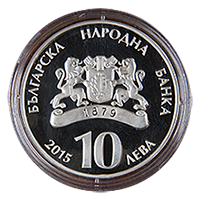
|
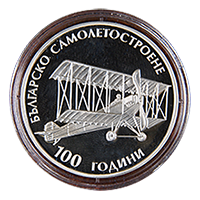
|
A tribute to Assen Jordanoff was paid in 1996 – 100th year of his birth. The Bulgarian government and the US Embassy in Sofia joined forces in a common commemoration. A TV crew and a journalist were sent to The United States and France to gather documents, make interviews and prepare a film. The Bulgarian parliament held a special session in Jordanoff's honor and a street in Sofia was chosen to bear his name. For this occasion his sister Milka Markowa-Totevy published her reminiscence book "Assen Jordanoff and Aviation."
Also in 2005 another TV team went to The United States to collect more facts on Jordanoff's life and career. A new film has been completed.
2015 marked the 100th anniversary of Jordanoff's successful project, an entire century since the flight of the fragile plane created by the visionary who started the aircraft building in Bulgaria. Bulgaria paid homage to the distinguished aircraft designer, early aviator, and aviation writer. The Central Bank of the Republic of Bulgaria issued a silver commemorative coin "100 Years of Bulgarian Aircraft Industry" featuring an image of the first bulgarian powered airplane - the biplane designed and built by Assen Jordanoff.
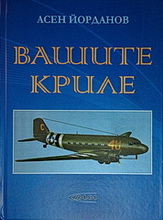
|

|
Could anyone say that the world is going in the wrong direction?! Assen Jordanoff's most successful book "Your Wings" was published in Bulgaria. This happened 79 (seventy-nine!) years after its original publishing in The United States. The handbook of many generations of fliers which in many states was their official textbook is still deservedly popular thanks to its specific visual education style. The new edition comes thanks to the effort of professor Boris Bonev, head of Bulgarian Air and Space Agency (BASA). There are forewords by professor Bonev and Peter Athanassov, Assen Jordanoff's nephew. Book's many illustrations are translated together with the text, all measurements are converted to metric, and all aviation-specific terms are adjusted to their proper Bulgarian equivalents as well. It is great that we read in Peter Athanassov's foreword "...this book to be known and used in Bulgaria, where it all started!"
2016 marked yet another jubilee – the 120th birth anniversary of Assen Jordanoff, one of world aviation's creators and teachers. An idea was born and gained the solid and enthusiastic support of the entire aviation society in Bulgaria – The Sofia International Airport to be named after Assen Jordanoff. This intention is also strongly supported by many Bulgarians living outside the country. The National Committee Of The Aviation Society In Bulgaria addressed Bulgarian institutions with an open letter. This letter represents the grounds to name the Sofia International Airport after Assen Jordanoff: it is a world practice that airports are named after corresponding country's distinguished figures who are world-famous and contributed to the advance of humanity. More about the initiative here: http://jordanoff.org.
I thank everybody who helped me in writing this article supplying me with materials and information: Mr. Georges Markow-Totevy and Mr. Peter Athanassov, nephews of Assen Jordanoff, Mr. Paul Lee, Mr. Ralph Cooper, Mr. Tim Linder, Mr. Greg Powers and Mr. Phill Wieser, Ph.D. Dimitris Vogiatzis. I also thank Mrs. Darina Boneva, and Mr. Ivan Borislavov for their observations, and of course prof. Bonev for "Your Wings!"
To my surprise I still find some references to Jordanoff's books in present-day internet sites and forums in Russia, recommending them as a good elementary reading - what a good recognition for well done work more than 60 years after its creation, in the XXI-st century! Today (2008) the Russian translation of Your Wings from 1937 (Ваши крылья) is still in circulation in .pdf format. The 1940 translation of Through the Overcast (Полеты в облаках) is also available on the net.
Plamen Antonov
April 2004 - January 2016
Assen Jordanoff's watch at eBay:
Jordanoff's gold watch appeared at eBay in April 2005 and is now (April 2005) part of Paul Lee's collection. The back of the watch reads: "To Assen Jordanoff From Dean C. Smith (for Cash)." Dean C. Smith was one of air mail service pioneers in The United States during the 20s. I was happy to see on the net two nice pages: The Early Birds of Aviation page about Dean Smith and his page at Chasing The Sun. Pictures below are courtesy of Mr. Lee.
 |
 |
Some articles and films by Assen Jordanoff:
SPORT FLYING IS HAILED TO GIVE WIDER HORIZONS: High Cost of Plane Per Hour Becomes Economy When Compared With Car On Mileage Basis, New York Times, Jun 15, 1930, pg. XX5;
Diver Flies, Flyer Dives, Popular Science Monthly, January 1931;
UNIT PARACHUTES CALLED PRACTICAL: Flier Believes Transport Planes Adaptable To Use of Packs--No Fear Complex, Wide World Photo, New York Times, Apr 26, 1931, pg. XX8;
Will Autogiro Banish Present Plane, Popular Science Monthly, March 1931;
CHECK FOR PLANE LIFE Pilot Urges Revolution Recorder in Place Of Time Log: Stunts Bring Extra Strains. Fixes Time for Overhaul., New York Times, Jul 5, 1931, pg. 97;
Thrills I Get in Piloting Air Taxis, Popular Science Monthly, July 1931;
What Pupils Taught Me About Flying, Popular Science Monthly, November 1931;
Flying, Popular Science Monthly, January 1932;
The First Fighting Squadron, Sportsman pilot, February 1932;
Stunt Flying, Popular Science Monthly, May 1932;
ELMER TAKES THE AIR, Paramount Pictures 1942-43. Аn educational film, containing 40 lessons, made by Jordanoff for the Unites States Airforce, used for years in AF bases.
Some articles and films about Assen jordanoff:
GO 6,000 MILES; FIND AIR RACE POSTPONED: Two Young Bulgarian Fliers Travel From Sofia, Spending $2,500. RELIED ON BERLIN MAGAZINE Notice of $1,000,000 Contest Here Was Published, but Postponement Was Not., New York Times, Sep 4, 1921, pg. 21;
DESIGNER SHOWS HOW STABILITY AIDS PLANE SAFETY: NEW MODEL SHOWS FAST CLIMB, By CLARENCE D. CHAMRERLIN. New York Times, Mar 16, 1930, pg. XX8;
EDISON FORECASTS 'EYE' FOR FOG FLYING: Taking First Ground Lesson, He Hints Device Might Convert Light Into Sound. TURNS TABLES ON TEACHER Expounds Theories to Jordanoff, Plane Designer--Sees Future for Helicopter Machines., Special to The New York Times, New York Times, Oct 3, 1930, pg. 29;
'FROZEN' GASOLINE CURBS PLANE PERIL: Dry Ice and Alcohol Cool the Liquid, Thus Reducing Danger From Fire, New York Times, Jan 16, 1939, pg. 17;
JORDANOFF TO ISSUE AVIATION MANUALS, Publishers Weekly v. 143, Jan 2, 1943

|
|
Publishers Weekly |
McLaughlin Joins Jordanoff, New York Times, Nov 15, 1942, pg. F8;
Assen Jordanoff Is Divorced, Special to THE NEW YORK TIMES, New York Times, Nov 28, 1942, pg. 11;
AVIATION FIRM' EXPANDS: Jordanoff Co. Leases Additional Space in Madison Ave., New York Times, Apr 14, 1943, pg. 38;
Fitzpatrick Joins Jordanoff, New York Times, Jul 21, 1943, pg. 22;
Jordanoff Aviation Corp. Announces His Promotion, New York Times, May 4, 1945, pg. 28;
PATENT GIVES TILT TO LANDING STRIP: Slant Would Reduce Length, Fences Cut Noise--Other New Inventions Listed Weight For Washline Three-Way Photography VARIETY OF IDEAS IN NEW PATENTS Porous Cooking Griddle Antibiotic Ice For Underwater Plowing Three-Functional Stadia, By STACY V. JONES Special to The New York Times, New York Times, Oct 13, 1956, pg. 25;
ASSEN JORDANOFF, AVIATION PIONEER: Stunt Flier Is Dead at 71, Fought in World War I, New York Times, Oct 19, 1967, pg. 47;
L'INDUSTRIE AERONAUTIQUE BULGARE by Col. Svetoslav Spirov, Fana de l'Aviation, Paris 1991.
BULGARIAN WINGS, Bulgarian National Television, Vreme Studio, Sofia 2005. TV film.
Assen Jordanoff and Aviation by Milka Markowa-Totevy, sister of Jordanoff, Societe des Gens de Lettres, Paris 1995 (in Bulgarian, titled "Асен Йорданов и Авиацията"), Sofia 1998 (in English);
FORGOTTEN GLORY - THE BULGARIAN AIRCRAFT PRODUCTION (ЗАБРАВЕНА СЛАВА - БЪЛГАРСКОТО САМОЛЕТОСТРОЕНЕ) by Ivan Borislavov, Vanio Nedkov Publishing, Sofia 1997;
FROM PAGES OF BULGARIAN MILITARY AVIATION: THE BALKAN WAR 1912-1913 (Из страниците на българската военна авиация: Балканската война 1912-1913 г.) by Radul Milkov, Military Publishers, Sofia 2003 (Written 1959);
THE BALKAN EAGLES (БАЛКАНСКИТЕ ОРЛИ) by Tsvetan Tsakov, Military Publishers, Sofia 1981;
George Markow-Totevy, nephew of Assen Jordanoff, grand-son of Marko Totev and founder of The Markow Totevy Foundation;
PETER ATHANASSOV, nephew of Assen Jordanoff;
RALPH COOPER - Ralph Cooper's Early Birds;
TIM LINDER;
CHRIS MULLEN;
PAUL LEE;
GREG POWERS and PHILL WIESER;
DIMITRIOS VOGIATZIS;
Bulgarian aviation constructor Assen Jordanoff - the pride of American aircraft industry (Българският авиоконструктор Асен Йорданов - гордостта на американското самолетостроене) by Konstantin Stoyanov Okela;
Bulgarian Assen Jordanoff gave wings to American aircraft and aerospace industry (Българинът Асен Йорданов даде криле на американското самолетостроене и аеронавтика) by Mitre Stamenov, Macedonia newspaper, #3, 21 Jan 1998;
Bozhuriste - the airfield with a name of a flower (a photo reminiscence) (Божурище - летището с име на цвете (фотоспомен)) by Ivan Borislavov and Nayden Ditchev;
Marko Totev's grandson invites our violinists to USA and France (Внук на Марко Тотев кани наши цигулари в САЩ и Франция), Standart newspaper, Sofia, 17 Sep 2000.
Don't miss Ralph Cooper's Early Birds.

